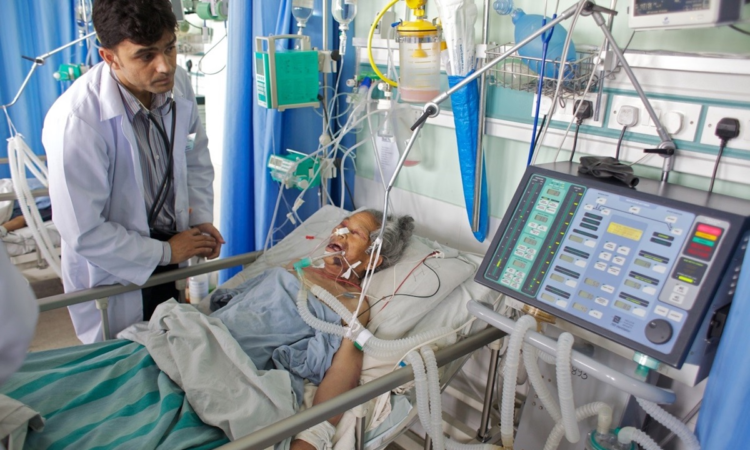
Sepsis is a serious condition that happens when the body’s immune system has an extreme response to an infection. The body’s reaction causes damage to its own tissues and organs.
Sepsis can affect anyone, but people who are older, very young, pregnant or have other health problems are at higher risk.
Common signs of sepsis include fever, fast heart rate, rapid breathing, confusion and body pain. It can lead to septic shock, multiple organ failure and death.
Sepsis is usually caused by bacterial infections but may be the result of other infections such as viruses, parasites or fungi.
Treatment for sepsis requires medical care. It will include antimicrobials, intravenous fluids and careful monitoring.
Sepsis acquired in health care settings is one of the most frequent adverse events during care delivery and affect hundreds of millions of patients worldwide every year.
Healthcare-associated infections are caused by organisms / pathogens that are often resistant to drugs and can rapidly lead to deteriorating clinical conditions. Antimicrobial resistance is a major factor determining clinical unresponsiveness to treatment and rapid evolution to sepsis and septic shock. Sepsis patients with resistant pathogens have been found to have a higher risk of hospital mortality.
Implementing preventive measures against infections, such as good hygiene practices, ensuring access to vaccination programmes, improved sanitation and water quality and availability, and other infection prevention and control best practices both in the community and health care settings, are key steps in reducing the occurrence of sepsis. Early diagnosis and timely and appropriate clinical management of sepsis, such as optimal antimicrobial use and fluid resuscitation, are crucial to increase the likelihood of survival. Even though the onset of sepsis can be acute and poses a short-term mortality burden, it can also be the cause of significant long-term morbidity requiring treatment and support. Thus, sepsis requires a multidisciplinary approach.
Anyone affected by an infection, severe injury, or serious non-communicable disease can progress to sepsis but vulnerable populations are at higher risk (2) including:
Sepsis is a medical emergency. It can cause different signs and symptoms at different times. People who think they may have sepsis should seek medical care right away.
Common signs and symptoms include:
Symptoms in children include:
In children under 5 years old, it can cause difficulty feeding, frequent vomiting or lack of urination.
In 2017, the largest contributors to sepsis cases and sepsis-related mortality across all ages were diarrhoeal diseases (9.2 to 15 million annual cases) and lower respiratory infections (1.8–2.8 million annually) (1). However, non-communicable diseases are on the rise; one-third of sepsis cases and nearly half of all sepsis-related deaths in 2017 were due to an underlying injury or chronic disease (1). Maternal disorders were the most common non-communicable disease complicated by sepsis. Among children, the most common causes of sepsis-related deaths were neonatal disorders, lower respiratory infections, and diarrhoeal diseases (1). Group B streptococcus is the leading cause of both neonatal and maternal sepsis, though Escherichia coli is an emerging threat (3,4). Both pathogens have displayed considerable resistance to treatment and are considered priority pathogens for research and development of new antibiotics.
Sepsis can be prevented by treating infections early and through good hygiene at home and in healthcare settings.
The best way to reduce the risk of sepsis is to avoid infections. Steps include:
Hospitals and clinics should follow effective rules for infection prevention and control. Antibiotics should be used appropriately to treat infections.
Sepsis is always a serious condition but people living with HIV, tuberculosis, malaria and other infectious diseases are at higher risk.
Treatment for sepsis is most effective when started early.
Health workers watch for concerning signs and use tests to diagnose sepsis. They will then work to find the source of the infection. Early use of antimicrobials to treat bacteria, parasites, fungus or viruses is essential to improve outcomes from sepsis.
Low blood pressure is treated by intravenous fluids and sometimes medicines called vasopressors, which can increase blood pressure.
Antibiotic resistance can make treatment more difficult.
Sepsis is a significant cause of maternal, neonatal and child mortality. Consequently, combating sepsis will contribute to achievement of Sustainable Development Goals (SDGs) targets 3.8 on quality of care, and 3.1 and 3.2 by improving mortality rates in these vulnerable populations. Sepsis can also ultimately lead to death in patients affected by HIV, tuberculosis, malaria, and other infectious diseases that are included in target 3.3. The prevention and/or appropriate diagnosis and management of sepsis is also linked to adequate vaccine coverage, quality universal health coverage, capacity to comply with the International Health Regulations, preparedness, and water and sanitation services. The challenge, however, remains how to achieve universal prevention, diagnosis and management of sepsis.
To combat this important global health threat, WHO responded with a WHO Secretariat Report and, in May 2017, the Seventieth World Health Assembly adopted Resolution WHA70.7 on Improving the prevention, diagnosis and clinical management of sepsis. The key pillars of Resolution WHA 70.7 are to:
In collaboration and coordination with WHO regional offices, Member States and other stakeholders, several WHO headquarters programmes are currently working on the public health impact of sepsis and providing guidance and country support on sepsis prevention, early and appropriate diagnosis, and timely and appropriate clinical management.
References
Related
News







